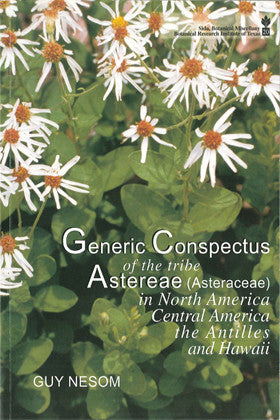The BRIT Store
Generic Conspectus of the Tribe Astereae (Asteraceae) in North America and Central America, the Antilles, and Hawaii
Generic Conspectus of the Tribe Astereae (Asteraceae) in North America and Central America, the Antilles, and Hawaii
Couldn't load pickup availability
Author:
Guy L. Nesom
SBM 20
ISSN 0883-1475
ISBN-13: 978-1-889878-06-5
Publication Date: 31 October 2000
Copyright © 2000 Botanical Research Institute of Texas
Specifications: 7"×10" (pbk), 96 pp.
About the Book
Asters (Aster), fleabanes (Erigeron), goldenrods (Solidago), rabbitbrush (Chrysothamnus), and silverling (Baccharis) are among the most abundant and conspicuous species of the sunflower family in North America. This part of the family (the tribe Astereae) also includes genera with fewer and less conspicuous species, many of them rare. The conspectus provides an overview of the 91 genera of Astereae native or adventive (non-native, outside of cultivation) in North America (including Mexico), Central America, the Antilles, and the Hawaiian Islands. It begins with a summary of the tribe, and then for each genus—synonyms, technical description, number of species, morphological distinctions, geographic distributions, major taxonomic subdivisions, controversies regarding generic definitions, and references to pertinent literature.
By recognizing or submerging segregates, proposals have been made in the last few decades to modify concepts of many genera of Astereae (Aster, Chrysopsis, Chrysothamnus, Conyza, Ericameria, Grindelia, Haplopappus, Lessingia, Machaeranthera, Solidago, and others). Aster and Haplopappus in North America would be nearly completely redistributed among generic segregates, but Grindelia, Lessingia, and Ericameriawould be enlarged. Many of these proposals remain controversial and many ideas for research arise in the discussions.
New evidence will suggest further taxonomic changes, but anyone dealing now with aspects of the flora needs to make decisions about what names to use, and for those wanting perspective on recent developments (what’s happened to Aster and Haplopappus?), here is a good place to start.


